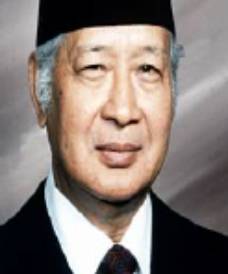
|
Suharto (1921- ) |
1965, Indonesia: Executing a Campaign of Mass Murder
By Kathy Kadane, States News Service, 1990.
The U.S. government played a significant role in one of the worst massacres of the century by supplying the names of thousands of Communist Party leaders to the Indonesian army, which hunted down the leftists and killed them. Former deputy CIA station chief Joseph Lazarsky and Robert Martens' former boss Edward Masters, said that in 1965, CIA agents helped compile lists of Communists.
Former senior U.S. diplomats and CIA officers aided army leader Suharto in his attack on the Partai Komunis Indonesia (PKI). Martens, was a member of the U.S. Embassy's political section and is now a State Department consultant. He said "They probably killed a lot of people and I probably have a lot of blood on my hands, but that's not all bad. There's a time when you have to strike hard at a decisive moment."
Martens headed an embassy group of State Department and CIA officers that compiled the death lists. He later delivered them to an army intermediary. People named on the lists were captured in overwhelming numbers. Martens said "It's a big part of the reason the PKI never come back."
The PKI was the third-largest Communist Party in the world, with an estimated three million members. Through affiliated organizations such as labor and youth groups it claimed the loyalties of another 17 million. In 1966, the Washington Post published an estimate that 500,000 were killed. [Other estimates put the death toll above one million.] In 1968, the CIA called the carnage "one of the worst mass murders of the 20th century."
Approval to release the lists came from former Ambassador Marshall Green, deputy chief of mission, Jack Lydman and political section chief Edward Masters, the three acknowledged in interviews.
Declassified embassy cables and State Department reports from October 1965, before the lists were turned over, show that U.S. officials knew Suharto was rounding up PKI cadres, and that firing squads were reportedly being formed to kill them.
Former CIA Director William Colby compared the embassy's campaign with the Phoenix Program set up in Vietnam in 1967. In 1965, Colby was was responsible for directing U.S. covert strategy in Asia. "That's what I set up in the Phoenix Program. That's exactly what it was," he said. "The idea of identifying the local apparatus was designed to - well, you go out and get them to surrender, or you capture or you shoot them," said Colby of Phoenix.
In 1962, when he was chief of the CIA's Far East division, Colby said the U.S. did not have comprehensive lists of PKI activists. The lists, he said, were useful for "operation planning."
The lists detailed the leadership of the party, Martens said. They included names of provincial, city and other local PKI committee members and leaders of "mass organizations," such as the PKI national labor federation, women's and youth groups.
"I know we had a lot more information" about the PKI "than the Indonesians," Green said. Masters, the embassy's political section chief, said the Indonesian army's lists were not as comprehensive as the U.S. lists.
Martens admits supplying thousands of names to an Indonesian emissary who was an aide to Adam Malik, an Indonesian minister and ally of Suharto in the attack on Communists. Interviewed in Jakarta, the aide, Tirta Kentjana ("Kim") Adhyatman, confirmed Martens' account he gave the U.S. lists to Suharto's headquarters.
Embassy officials carefully recorded the subsequent destruction of the PKI. They checked off names of captured and assassinated PKI leaders, tracking the dismantling of the party apparatus, former U.S. officials said. Information about who had been captured and killed came from Suharto's headquarters, according to Lazarsky, the deputy CIA station chief in 1965.
"The army had a 'shooting list' of about 4,000 or 5,000 people," Lazarsky said. Detention centers were set up to hold those who were not killed immediately. "They didn't have enough goon squads to zap them all, and some were valuable for interrogation," he said. "The infrastructure was zapped almost immediately. We knew what they were doing." The checkoff work was also done at the CIA's intelligence directorate in Washington.
By January 1966, Lazarsky said, CIA analysts in Washington concluded the PKI leadership was destroyed. "No one cared, as long as they were Communists, that they were being butchered," said Howard Federspiel, who was the Indonesia expert at the State Department's Bureau of Intelligence and Research in 1965.
Colby said, "We came to the conclusion that with the sort of Draconian way it was carried out, it really set them back for years."
Source: "Ex-agents say CIA compiled death lists for Indonesians," San Francisco Examiner, May 20, 1990.
users.westnet.gr/~cgian/suha-cia.htm
joined Dutch colonial army (1940), a Japanese-led militia (1942) and the Indonesian army (1945)
led military operations suppressing Muslim and Dutch-led uprisings in Indonesia (early 1950s)
took control of the central Javanese army (1957)
became brigadier general (1960) and led a military operation to recover West Irian (1962)
took lead of army's strategic command (1963)
oversaw the CIA-backed campaign of mass murder to overthrow Pres. Sukarno (1965), transferred power to military (1967) and ruled as President (1968-1998).
Source: encarta.msn.com
is believed to have amassed US$40 billion through corruption.
"Within a year of the bloodbath, Indonesia's economy was redesigned in America, giving western capital access to vast mineral wealth, markets and cheap labor."
John Pilger, Dec. 25, 2000, New Statesman.